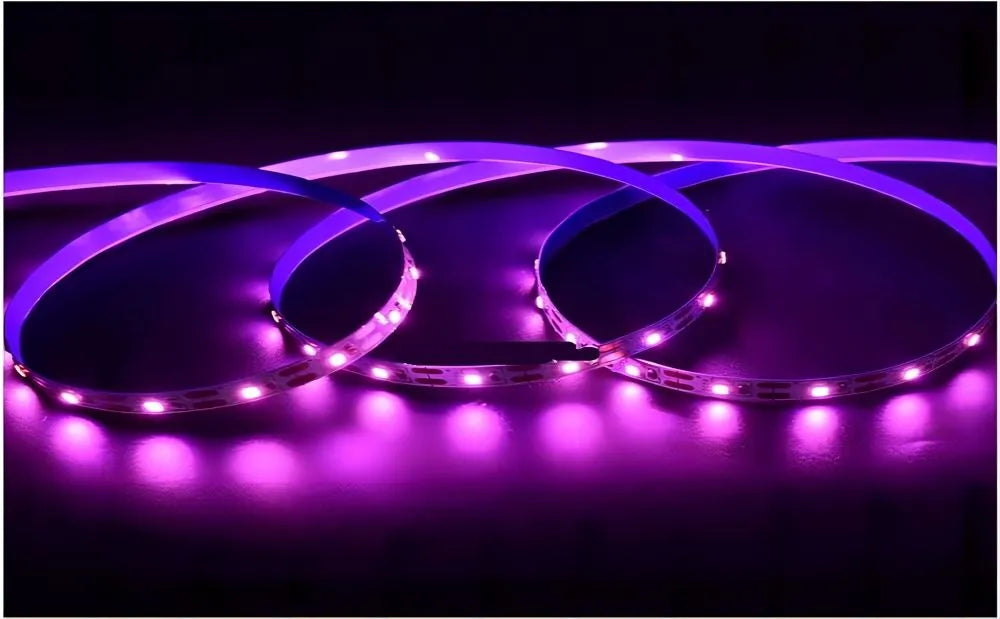Introduction
In this article, we will explore the world of outdoor LED strip lights and learn about their benefits in enhancing outdoor spaces. Whether you want to create a cozy ambiance or add a touch of elegance to your outdoor area, LED strip lights are a versatile and energy-efficient lighting solution.

I.Types of Outdoor LED Strip Lights:
There are several types available in the market. Here are some common types that you can consider for your outdoor lighting needs:
- RGB Color-Changing LED Strip Lights:
RGB color-changing LED strip lights are a popular choice for outdoor lighting due to their versatility. These strips contain red, green, and blue LEDs that can be mixed to create a wide range of colors. With the help of a controller, you can easily change the colors and create dynamic lighting effects.
- Single-Color LED Strip Lights:
Single-color LED strip lights are available in various colors, such as warm white, cool white, or different shades of white. These strips are perfect for creating a specific ambiance or providing functional lighting in outdoor spaces.
- High-Density LED Strip Lights:
High-density LED strip lights have more LEDs per meter, resulting in a brighter and more uniform illumination. These strips are suitable for applications where you need intense lighting or want to highlight specific areas or objects in your outdoor space.
- Flexible LED Strip Lights:
Flexible LED strip lights are designed with a flexible circuit board, allowing you to bend or shape them according to your needs. These strips are ideal for curved or irregularly shaped outdoor surfaces, such as pillars, arches, or signs.
- Neon LED Strip Lights:
Neon LED strip lights mimic the appearance of traditional neon lights but are more energy-efficient and durable. These strips are a trendy choice for creating a vibrant and eye-catching lighting display in outdoor areas.
- High-CRI LED Strip Lights:
High-CRI (Color Rendering Index) LED strip lights are designed to accurately render colors, making them suitable for applications where color accuracy is essential. These strips are commonly used in outdoor spaces where showcasing the true colors of objects or landscapes is desired.
- Addressable LED Strip Lights:
Addressable LED strip lights feature individually controllable LEDs, allowing you to create intricate lighting patterns and effects. With the help of a controller and programming software, you can program different colors and animations for each LED, offering endless possibilities for outdoor lighting designs.
When selecting the type of outdoor LED strip lights, consider factors such as the desired lighting effect, brightness, color options, and compatibility with your outdoor space. Additionally, ensure that the chosen LED strip lights have the necessary IP rating to withstand outdoor conditions and are suitable for your intended application.
II. Factors to Consider When Choosing Outdoor LED Strip Lights
Here are some key factors to consider when choosing outdoor LED strip lights
1. Brightness: Choose the brightness that you want for your outdoor area.
2. Color Temperature: Select the hue that gives the atmosphere you want.
3. IP Rating: To provide protection from dust and moisture, use LED strip lights with a high IP rating.
4. Power Source Compatibility: Verify that your power source and the LED strip lights work together.
5. Length and Cut Points: For an exact fit, take into account the LED strip lights' length and cut points.
6. Sturdiness and Weather Resistance: Seek for characteristics unique to the outdoors, such as waterproofing and UV resistance.
7. Dimming and Control Options: Choose from smart control options and dimming capabilities.
8. Electricity Efficiency: To save electricity, go for LED strip lights with a high lumen-to-watt ratio.
9. Warranty and Brand repute: Take into account the brand's dependability and repute.
You can choose outdoor LED strip lights that satisfy your unique requirements and offer enduring performance by taking these variables into account.
III. How To Install Outdoor LED Strip Lights
Installing outdoor LED strip lights can be a straightforward process if you follow the correct steps. Here is a general guide on how to install outdoor LED strip lights:
- Plan and Design: Determine where you want to install the LED strip lights and plan the layout accordingly. Consider the power source location, the desired lighting effect, and any obstacles or challenges you may encounter.
- Prepare the Area: Ensure the installation area is clean and dry. Clear any debris or obstructions that may interfere with the installation process.
- Mounting: Attach the LED strip lights to the desired surface using mounting clips, adhesive backing, or brackets. Make sure the mounting method is secure and will withstand outdoor conditions.
- Connect the LED Strips: If your LED strip lights come in segments, connect them using connectors or soldering. Follow the manufacturer's instructions for proper connection methods.
- Power Supply: Determine the appropriate power supply for your LED strip lights. Depending on the voltage requirements, you may need to install a transformer or power adapter. Connect the power supply to the LED strips, ensuring proper polarity.
- Test the Lighting: Before permanently securing the LED strip lights, test the lighting to ensure they are functioning correctly. Make any necessary adjustments to the installation or wiring if needed.
- Secure and Protect: Once you are satisfied with the lighting, secure any loose wiring and ensure all connections are properly insulated. Use waterproofing techniques, such as silicone sealant or waterproof tape, to protect the connections and exposed parts from moisture.
- Safety Precautions: Follow electrical safety guidelines and ensure all connections are secure and insulated. If you are unsure about any electrical work, it's always best to consult a professional electrician.
Remember to refer to the specific instructions provided by the manufacturer of your LED strip lights for any additional installation steps or considerations.
By following these steps and taking necessary precautions, you can successfully install outdoor LED strip lights to enhance your outdoor space with beautiful and energy-efficient lighting.
IV. Outdoor Waterproof LED Strip Lights
Outdoor waterproof LED strip lights are designed to be used in outdoor environments where protection against moisture and water is necessary. They are equipped with a high IP rating, typically IP65 or higher, which ensures resistance to dust and low-pressure water jets. These LED strip lights have a protective coating, often made of silicone, that prevents water from penetrating the circuitry. They are also UV resistant, allowing them to withstand prolonged exposure to sunlight without fading or deteriorating. Installation of outdoor waterproof LED strip lights should be done following the manufacturer's instructions, ensuring proper sealing and secure attachment to the outdoor surface. With their durability and ability to withstand outdoor conditions, these LED strip lights are an excellent choice for enhancing the ambiance and functionality of outdoor spaces.
V. Weatherproof and Durability Features
Here are some key weatherproof and durability features to consider when selecting outdoor LED strip lights:
- IP Rating: Choose lights with a high IP rating (e.g., IP65 or higher) for protection against dust, moisture, and water jets.
- Waterproof Coating: Look for lights with a waterproof coating, usually made of silicone, to prevent water damage.
- UV Resistance: Select lights that are UV resistant to prevent fading and deterioration from sunlight exposure.
- Temperature Tolerance: Ensure the lights can withstand extreme temperatures without affecting performance.
- Impact Resistance: Opt for lights with a robust construction that can withstand physical impact and vibrations.
- Corrosion Resistance: If the lights will be exposed to corrosive elements, choose corrosion-resistant materials like stainless steel.
- Vibration Resistance: Consider lights with vibration-resistant features to withstand constant vibrations without flickering or damage.
By considering these weatherproof and durability features, you can ensure that your lights will be able to withstand the elements and maintain optimal performance over time.
VI. Best Practices for Outdoor LED Strip Light Installation
Here are some key best practices for installing outdoor LED strip lights:
- Seal and protect all connections to prevent moisture ingress.
- Securely fasten and route wiring to avoid exposure and tripping hazards.
- Follow electrical safety guidelines and consult a professional if needed.
- Use appropriate mounting methods for the installation surface.
- Properly ground the LED strip light installation if required.
- Use weatherproof connectors and junction boxes to protect connections.
- Perform regular maintenance checks to ensure optimal performance.
- Follow the manufacturer's instructions and guidelines.
By following these best practices, you can ensure a safe and successful installation of outdoor LED strip lights.
VII. Maintenance and Care for Outdoor LED Strip Lights
To maintain and care for outdoor LED strip lights:
|
1 |
Regularly clean them to get rid of dust and grime. |
|
2 |
Check for damage and take quick action to resolve any problems. |
|
3 |
Swap out malfunctioning parts with superior substitutes. |
|
4 |
Use weatherproof materials and seal any connections to keep them safe from the outdoors. |
|
5 |
Make sure you use the right power supplies to prevent overloading circuits. |
|
6 |
For complex maintenance jobs or if you are unsure, get professional assistance. |
VIII.Comparison of Top Outdoor LED Strip Light Brands
When comparing top outdoor LED strip light brands, it's important to consider factors such as quality, durability, performance, and customer satisfaction. Here are a few well-regarded brands in the market:
1.Philips Hue: Known for their bright colors, premium build quality, and ability to work with smart home systems, Philips Hue has a selection of outdoor LED strip lights. They are frequently complimented for their variety of lighting options and simplicity of installation.
2. Govee: This well-known company is well-known for its reasonably priced and dependable outdoor LED strip lights. These items come with features like color-changing options, app control, and waterproofing, which strike a fair mix between quality and value.
3. LE LED Lighting EVER: This company has a large selection of outdoor LED strip lights with dimmable, waterproofing, and color-changing choices. They are renowned for their affordability, robustness, and energy efficiency.
4. LIFX: LIFX is known for its high-quality outdoor LED strip lights that provide bright and vibrant lighting. Their products often feature smart capabilities, such as compatibility with voice assistants and smartphone apps for easy control and customization.
5. HitLights: HitLights offers a range of outdoor LED strip lights suitable for various applications. Their products are known for their durability, flexibility, and easy installation. They offer options for both single color and color-changing lights.
6. OxyLED: OxyLED offers outdoor LED strip lights with features like waterproofing, color-changing options, and remote control. Their products are often praised for their durability, ease of use, and competitive pricing.
Conclusion
In conclusion, outdoor LED strip lights offer a versatile and energy-efficient way to enhance your outdoor space. By following the installation guide and considering factors like weatherproofing and durability, you can create a stunning outdoor lighting setup that will elevate the ambiance of your outdoor area.
FAQ
1. Do I need an electrician to install LED strip lights?
We do recommend consulting an electrician beforehand, When you're ready to install your LED strip lights, simply follow our step-by-step instructions below.
2. How long do LED strip lights last outside?
LED strip lights are noted for having a longer lifespan than traditional lighting alternatives. They typically last between 30,000 and 50,000 hours.
3. Are LED strips expensive to run?
LED strips, on the other hand, are extremely energy efficient, providing a large amount of light while producing little heat. LED strips are a cost-effective option for providing enough lighting while lowering electricity costs.

